Machine Learning-Based Models for the Prediction of Postoperative Recurrence Risk in MVI-Negative HCC
Abstract
1. Introduction
2. Materials and Methods
2.1. Subjects
2.2. Data Collected
2.3. Statistical Analysis
2.4. Follow-Up
3. Results
3.1. Patient Characteristics
3.2. Feature Selection in Models
3.3. Model Comparison
3.4. External Validation with Time-Specific MVI-Negative HCC Dataset
3.5. Cox Recurrence Model
3.6. Interpretability Analysis
4. Discussion
5. Limitations
6. Conclusions
Supplementary Materials
Author Contributions
Funding
Institutional Review Board Statement
Informed Consent Statement
Data Availability Statement
Conflicts of Interest
Abbreviations
| HCC | Hepatocellular carcinoma |
| MVI | Microvascular invasion |
| ER | Early recurrence |
| ML | Machine learning |
| DL | Deep learning |
| RFE | Recursive Feature Elimination |
| SHAP | SHapley Additive exPlanations |
| AUC | Area Under the Curve |
| ROC | Receiver Operating Characteristic |
| LR | Logistic Regression |
| SVM | Support Vector Machine |
| RF | Random Forest |
| GBM | Gradient Boosting Machines |
| XGBoost | eXtreme Gradient Boosting |
| LightGBM | Light Gradient Boosting Machine |
| CatBoost | Categorical Boosting |
| DFS | Disease-free survival |
| MRI | Magnetic Resonance Imaging |
| CT | Computed Tomography |
| AFP | Alpha-fetoprotein |
| TB | Total bilirubin |
| ALB | Albumin |
| EBL | Estimated blood loss |
| OT | Operation time |
| IQR | Interquartile range |
| SD | Standard deviation |
| AP | Average Precision |
| PFS | Progression-free survival |
| HBV | Hepatitis B Virus |
| HBsAg | Hepatitis B surface antigen |
| CA125 | Cancer Antigen 125 |
| CA199 | Carbohydrate Antigen 19-9 |
| GLR | Gamma-glutamyl transferase to lymphocyte ratio |
| AST | Aspartate Aminotransferase |
| Cr | Creatinine |
| APTT | Activated Partial Thromboplastin Time |
| ALP | Alkaline Phosphatase |
| BUN | Blood Urea Nitrogen |
| γ-GT | Gamma-glutamyl transferase |
| INR | International Normalized Ratio |
| D-BIL | Direct Bilirubin |
| CEA | Carcinoembryonic Antigen |
| PIVKA-II | Protein Induced by Vitamin K Absence or Antagonist-II |
| eGFR | Estimated Glomerular Filtration Rate |
| PTA | Prothrombin Time Activity |
| BCLC | Barcelona Clinic Liver Cancer |
| HBeAb | Hepatitis B e antibody |
| ASA | American Society of Anesthesiologists |
| NK cells | Natural Killer cells |
| Tregs | Regulatory T cells |
| MUC16 | Mucin 16 |
| OS | Overall Survival |
| RFS | Recurrence-free Survival |
| BMI | Body Mass Index |
References
- Bray, F.; Ferlay, J.; Soerjomataram, I.; Siegel, R.L.; Torre, L.A.; Jemal, A. Global cancer statistics 2018: GLOBOCAN estimates of incidence and mortality worldwide for 36 cancers in 185 countries. CA Cancer J. Clin. 2018, 68, 394–424. [Google Scholar] [CrossRef]
- Rumgay, H.; Arnold, M.; Ferlay, J.; Lesi, O.; Cabasag, C.J.; Vignat, J.; Laversanne, M.; McGlynn, K.A.; Soerjomataram, I. Global burden of primary liver cancer in 2020 and predictions to 2040. J. Hepatol. 2022, 77, 1598–1606. [Google Scholar] [CrossRef]
- Niu, Z.-S.; Wang, W.-H.; Niu, X.-J. Recent progress in molecular mechanisms of postoperative recurrence and metastasis of hepatocellular carcinoma. World J. Gastroenterol. 2022, 28, 6433–6477. [Google Scholar] [CrossRef]
- Parissa, T.; Ghalib, J.; Brian, S.; Myron, S.; Sasan, R. Recurrence of hepatocellular cancer after resection: Patterns, treatments, and prognosis. Ann. Surg. 2015, 261, 947–955. Available online: https://pubmed.ncbi.nlm.nih.gov/25010665/ (accessed on 17 June 2025).
- Liu, X.; Qiu, Z.; Ndhlovu, E.; Wan, Y.; Sun, H.; Wang, S.; Cao, Y.; Zhu, P. Establishing and Externally Validating a Hemoglobin, Albumin, Lymphocyte, and Platelet (HALP) Score-Based Nomogram for Predicting Early Recurrence in BCLC Stage 0/A Hepatocellular Carcinoma Patients After Radical Liver Resection: A Multi-Center Study. J. Hepatocell. Carcinoma 2024, 11, 1127–1141. [Google Scholar] [CrossRef]
- Lin, W.-P.; Xing, K.-L.; Fu, J.-C.; Ling, Y.-H.; Li, S.-H.; Yu, W.-S.; Zhang, Y.-F.; Zhong, C.; Wang, J.-H.; Chen, Z.-Y.; et al. Development and Validation of a Model Including Distinct Vascular Patterns to Estimate Survival in Hepatocellular Carcinoma. JAMA Netw. Open 2021, 4, e2125055. [Google Scholar] [CrossRef]
- Lee, S.; Kang, T.W.; Song, K.D.; Lee, M.W.; Rhim, H.; Lim, H.K.; Kim, S.Y.; Sinn, D.H.; Kim, J.M.; Kim, K.; et al. Effect of Microvascular Invasion Risk on Early Recurrence of Hepatocellular Carcinoma After Surgery and Radiofrequency Ablation. Ann. Surg. 2021, 273, 564–571. [Google Scholar] [CrossRef] [PubMed]
- Chan, A.W.H.; Zhong, J.; Berhane, S.; Toyoda, H.; Cucchetti, A.; Shi, K.; Tada, T.; Chong, C.C.N.; Xiang, B.-D.; Li, L.-Q.; et al. Development of pre and post-operative models to predict early recurrence of hepatocellular carcinoma after surgical resection. J. Hepatol. 2018, 69, 1284–1293. [Google Scholar] [CrossRef] [PubMed]
- Li, S.-H.; Mei, J.; Cheng, Y.; Li, Q.; Wang, Q.-X.; Fang, C.-K.; Lei, Q.-C.; Huang, H.-K.; Cao, M.-R.; Luo, R.; et al. Postoperative Adjuvant Hepatic Arterial Infusion Chemotherapy With FOLFOX in Hepatocellular Carcinoma With Microvascular Invasion: A Multicenter, Phase III, Randomized Study. J. Clin. Oncol. 2023, 41, 1898–1908. [Google Scholar] [CrossRef] [PubMed]
- Xin, Z.; Li, J.; Zhang, H.; Zhou, Y.; Song, J.; Chen, P.; Bai, L.; Chen, H.; Zhou, J.; Chen, J.; et al. Cancer Genomic Alterations Can Be Potential Biomarkers Predicting Microvascular Invasion and Early Recurrence of Hepatocellular Carcinoma. Front. Oncol. 2022, 12, 783109. [Google Scholar] [CrossRef]
- Qiu, Z.-C.; Cai, H.-Z.; Wu, Y.-W.; Dai, J.-L.; Qi, W.-L.; Chen, C.-W.; Xu, Y.-Q.; Li, C.; Wen, T.-F. Nomogram for predicting early cancer-related death due to recurrence after liver resection in hepatocellular carcinoma patients with Barcelona Clinic Liver Cancer (BCLC) stage B/C: A multicenter study. BMC Gastroenterol. 2025, 25, 14. [Google Scholar] [CrossRef]
- Haug, C.J.; Drazen, J.M. Artificial Intelligence and Machine Learning in Clinical Medicine, 2023. N. Engl. J. Med. 2023, 388, 1201–1208. [Google Scholar] [CrossRef] [PubMed]
- Kolker, E.; Özdemir, V.; Kolker, E. How Healthcare Can Refocus on Its Super-Customers (Patients, n = 1) and Customers (Doctors and Nurses) by Leveraging Lessons from Amazon, Uber, and Watson. OMICS 2016, 20, 329–333. [Google Scholar] [CrossRef] [PubMed]
- Murdoch, T.B.; Detsky, A.S. The inevitable application of big data to health care. JAMA 2013, 309, 1351–1352. [Google Scholar] [CrossRef] [PubMed]
- Tang, S.; Zhang, H.; Liang, J.; Tang, S.; Li, L.; Li, Y.; Xu, Y.; Wang, D.; Zhou, Y. Prostate cancer treatment recommendation study based on machine learning and SHAP interpreter. Cancer Sci. 2024, 115, 3755–3766. [Google Scholar] [CrossRef]
- An, C.; Kim, D.W.; Park, Y.-N.; Chung, Y.E.; Rhee, H.; Kim, M.-J. Single Hepatocellular Carcinoma: Preoperative MR Imaging to Predict Early Recurrence after Curative Resection. Radiology 2015, 276, 433–443. [Google Scholar] [CrossRef]
- Feng, L.; Huang, W.; Pan, X.; Ruan, F.; Li, X.; Tan, S.; Long, L. Predicting overall survival in hepatocellular carcinoma patients via a combined MRI radiomics and pathomics signature. Transl. Oncol. 2025, 51, 102174. [Google Scholar] [CrossRef]
- Reveron-Thornton, R.F.; Teng, M.L.P.; Lee, E.Y.; Tran, A.; Vajanaphanich, S.; Tan, E.X.; Nerurkar, S.N.; Ng, R.X.; Teh, R.; Tripathy, D.P.; et al. Global and regional long-term survival following resection for HCC in the recent decade: A meta-analysis of 110 studies. Hepatol. Commun. 2022, 6, 1813–1826. [Google Scholar] [CrossRef]
- Zhang, J.; Wang, Z.; Wu, Q.; Zeng, J.; Liu, J.; Zeng, J. Nomogram for predicting early recurrence of hepatocellular carcinoma with narrow resection margin. Sci. Rep. 2024, 14, 28103. [Google Scholar] [CrossRef]
- Chun, Y.S.; Pawlik, T.M.; Vauthey, J.-N. 8th Edition of the AJCC Cancer Staging Manual: Pancreas and Hepatobiliary Cancers. Ann. Surg. Oncol. 2018, 25, 845–847. [Google Scholar] [CrossRef]
- Reig, M.; Forner, A.; Rimola, J.; Ferrer-Fàbrega, J.; Burrel, M.; Garcia-Criado, Á.; Kelley, R.K.; Galle, P.R.; Mazzaferro, V.; Salem, R.; et al. BCLC strategy for prognosis prediction and treatment recommendation: The 2022 update. J. Hepatol. 2022, 76, 681–693. [Google Scholar] [CrossRef] [PubMed]
- Zhang, Y.-B.; Yang, G.; Bu, Y.; Lei, P.; Zhang, W.; Zhang, D.-Y. Development of a machine learning-based model for predicting risk of early postoperative recurrence of hepatocellular carcinoma. World J. Gastroenterol. 2023, 29, 5804–5817. [Google Scholar] [CrossRef]
- Zhang, J.; Qin, S.D.; Li, Y.; Lu, F.; Gong, W.F.; Zhong, J.H.; Ma, L.; Zhao, J.F.; Zhan, G.H.; Li, P.Z.; et al. Prognostic significance of combined α-fetoprotein and CA19-9 for hepatocellular carcinoma after hepatectomy. World J. Surg. Oncol. 2022, 20, 346. [Google Scholar] [CrossRef]
- Zang, Y.; Long, P.; Wang, M.; Huang, S.; Chen, C. Development and validation of prognostic nomograms in patients with hepatocellular carcinoma: A population-based study. Future Oncol. 2021, 17, 5053–5066. Available online: https://www.tandfonline.com/doi/full/10.2217/fon-2020-1065 (accessed on 10 December 2024). [CrossRef]
- Sohn, W.; Paik, Y.-H.; Kim, J.M.; Kwon, C.H.; Joh, J.W.; Cho, J.Y.; Gwak, G.-Y.; Choi, M.S.; Lee, J.H.; Koh, K.C.; et al. HBV DNA and HBsAg levels as risk predictors of early and late recurrence after curative resection of HBV-related hepatocellular carcinoma. Ann. Surg. Oncol. 2014, 21, 2429–2435. [Google Scholar] [CrossRef]
- Liu, Y.; Veeraraghavan, V.; Pinkerton, M.; Fu, J.; Douglas, M.W.; George, J.; Tu, T. Viral Biomarkers for Hepatitis B Virus-Related Hepatocellular Carcinoma Occurrence and Recurrence. Front. Microbiol. 2021, 12, 665201. [Google Scholar] [CrossRef]
- Kobayashi, S.; Saigoh, K.; Urashima, T.; Asano, T.; Isono, K. Detection of hepatitis B virus x transcripts in human hepatocellular carcinoma tissues. J. Surg. Res. 1997, 73, 97–100. [Google Scholar] [CrossRef] [PubMed]
- Wang, Q.; Lin, L.; Yoo, S.; Wang, W.; Blank, S.; Fiel, M.I.; Kadri, H.; Luan, W.; Warren, L.; Zhu, J.; et al. Impact of non-neoplastic vs intratumoural hepatitis B viral DNA and replication on hepatocellular carcinoma recurrence. Br. J. Cancer 2016, 115, 841–847. [Google Scholar] [CrossRef] [PubMed]
- Cho, W.T.; Yoo, T.; Lee, J.M.; Lee, J.W.; Kim, H.; Lee, J.S.; Han, S.H. Hepatitis B Virus DNA-Level Change is Associated With Tumor Recurrence in Patients With Resected Hepatitis B Virus Hepatocellular Carcinoma. J. Surg. Res. 2024, 295, 231–239. [Google Scholar] [CrossRef]
- Poon, R.T.-P.; Fan, S.-T. Hepatectomy for hepatocellular carcinoma: Patient selection and postoperative outcome. Liver Transpl. 2004, 10, S39–S45. [Google Scholar] [CrossRef]
- Pandey, D.; Lee, K.-H.; Wai, C.-T.; Wagholikar, G.; Tan, K.-C. Long term outcome and prognostic factors for large hepatocellular carcinoma (10 cm or more) after surgical resection. Ann. Surg. Oncol. 2007, 14, 2817–2823. [Google Scholar] [CrossRef] [PubMed]
- Solhi, R.; Pourhamzeh, M.; Zarrabi, A.; Hassan, M.; Mirzaei, H.; Vosough, M. Novel biomarkers for monitoring and management of hepatocellular carcinoma. Cancer Cell Int. 2024, 24, 428. [Google Scholar] [CrossRef] [PubMed]
- Huang, Y.; Zeng, J.; Liu, T.; Lin, X.; Guo, P.; Zeng, J.; Zhou, W.; Liu, J. Prognostic Significance of Elevated Preoperative Serum CA125 Levels After Curative Hepatectomy for Hepatocellular Carcinoma. Onco Targets Ther. 2020, 13, 4559–4567. Available online: https://www.dovepress.com/prognostic-significance-of-elevated-preoperative-serum-ca125-levels-af-peer-reviewed-article-OTT (accessed on 10 December 2024). [CrossRef]
- Zhou, S.; Wang, Z.; Li, M.; Wu, L. Elevated Preoperative Serum CA125 Predicts Larger Tumor Diameter in Patients with Hepatocellular Carcinoma and Low AFP Levels. BioMed Res. Int. 2019, 2019, 6959637. Available online: https://www.hindawi.com/journals/bmri/2019/6959637/ (accessed on 10 December 2024). [CrossRef] [PubMed]
- Whiteside, T.L.; Mandapathil, M.; Szczepanski, M.; Szajnik, M. Mechanisms of tumor escape from the immune system: Adenosine-producing Treg, exosomes and tumor-associated TLRs. Bull. Cancer 2011, 98, E25–E31. [Google Scholar] [CrossRef]
- Fan, K.; Yang, C.; Fan, Z.; Huang, Q.; Zhang, Y.; Cheng, H.; Jin, K.; Lu, Y.; Wang, Z.; Luo, G.; et al. MUC16 C terminal-induced secretion of tumor-derived IL-6 contributes to tumor-associated Treg enrichment in pancreatic cancer. Cancer Lett. 2018, 418, 167–175. [Google Scholar] [CrossRef]
- Gubbels, J.A.A.; Felder, M.; Horibata, S.; Belisle, J.A.; Kapur, A.; Holden, H.; Petrie, S.; Migneault, M.; Rancourt, C.; Connor, J.P.; et al. MUC16 provides immune protection by inhibiting synapse formation between NK and ovarian tumor cells. Mol. Cancer 2010, 9, 11. [Google Scholar] [CrossRef]
- Belisle, J.A.; Horibata, S.; Jennifer, G.A.A.; Petrie, S.; Kapur, A.; André, S.; Gabius, H.-J.; Rancourt, C.; Connor, J.; Paulson, J.C.; et al. Identification of Siglec-9 as the receptor for MUC16 on human NK cells, B cells, and monocytes. Mol. Cancer 2010, 9, 118. [Google Scholar] [CrossRef]
- Bjørge, T.; Häggström, C.; Ghaderi, S.; Nagel, G.; Manjer, J.; Tretli, S.; Ulmer, H.; Harlid, S.; Rosendahl, A.H.; Lang, A.; et al. BMI and weight changes and risk of obesity-related cancers: A pooled European cohort study. Int. J. Epidemiol. 2019, 48, 1872–1885. [Google Scholar] [CrossRef]
- Ji, F.; Liang, Y.; Fu, S.; Chen, D.; Cai, X.; Li, S.; Peng, B.; Liang, L.; Hua, Y. Prognostic value of combined preoperative prognostic nutritional index and body mass index in HCC after hepatectomy. HPB 2017, 19, 695–705. Available online: https://linkinghub.elsevier.com/retrieve/pii/S1365182X17305695 (accessed on 11 December 2024). [CrossRef]
- Mathur, A.; Franco, E.S.; Leone, J.P.; Osman-Mohamed, H.; Rojas, H.; Kemmer, N.; Neff, G.W.; Rosemurgy, A.S.; Alsina, A.E. Obesity portends increased morbidity and earlier recurrence following liver transplantation for hepatocellular carcinoma. HPB 2013, 15, 504–510. Available online: https://linkinghub.elsevier.com/retrieve/pii/S1365182X15314210 (accessed on 11 December 2024). [CrossRef] [PubMed]
- El-Domiaty, N.; Saliba, F.; Karam, V.; Sobesky, R.; Ibrahim, W.; Vibert, E.; Pittau, G.; Amer, K.; Saeed, M.A.; Shawky, J.A.; et al. Impact of body mass index on hepatocellular carcinoma recurrence after liver transplantation through long-term follow-up. Hepatobiliary Surg. Nutr. 2021, 10, 598–609. Available online: https://hbsn.amegroups.com/article/view/40805/html (accessed on 11 December 2024). [CrossRef] [PubMed]
- Liang, B.; Gu, J.; Xiong, M.; Zhang, E.; Zhang, Z.; Chen, X.; Huang, Z. Tumor size may influence the prognosis of solitary hepatocellular carcinoma patients with cirrhosis and without macrovascular invasion after hepatectomy. Sci. Rep. 2021, 11, 16343. Available online: https://www.nature.com/articles/s41598-021-95835-5 (accessed on 11 December 2024). [CrossRef] [PubMed]
- Notarpaolo, A.; Layese, R.; Magistri, P.; Gambato, M.; Colledan, M.; Magini, G.; Miglioresi, L.; Vitale, A.; Vennarecci, G.; Ambrosio, C.D.; et al. Validation of the AFP model as a predictor of HCC recurrence in patients with viral hepatitis-related cirrhosis who had received a liver transplant for HCC. J. Hepatol. 2017, 66, 552–559. [Google Scholar] [CrossRef]
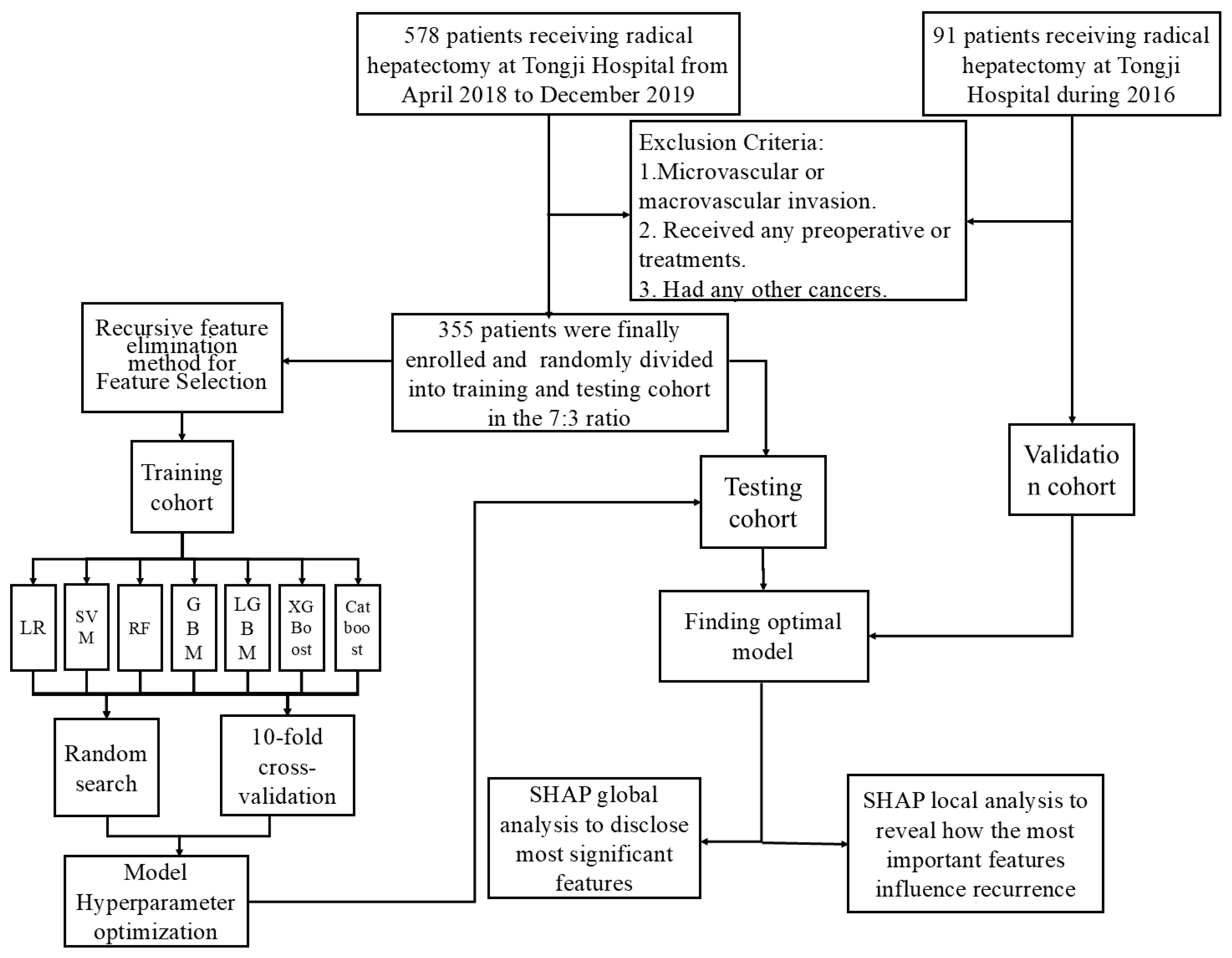

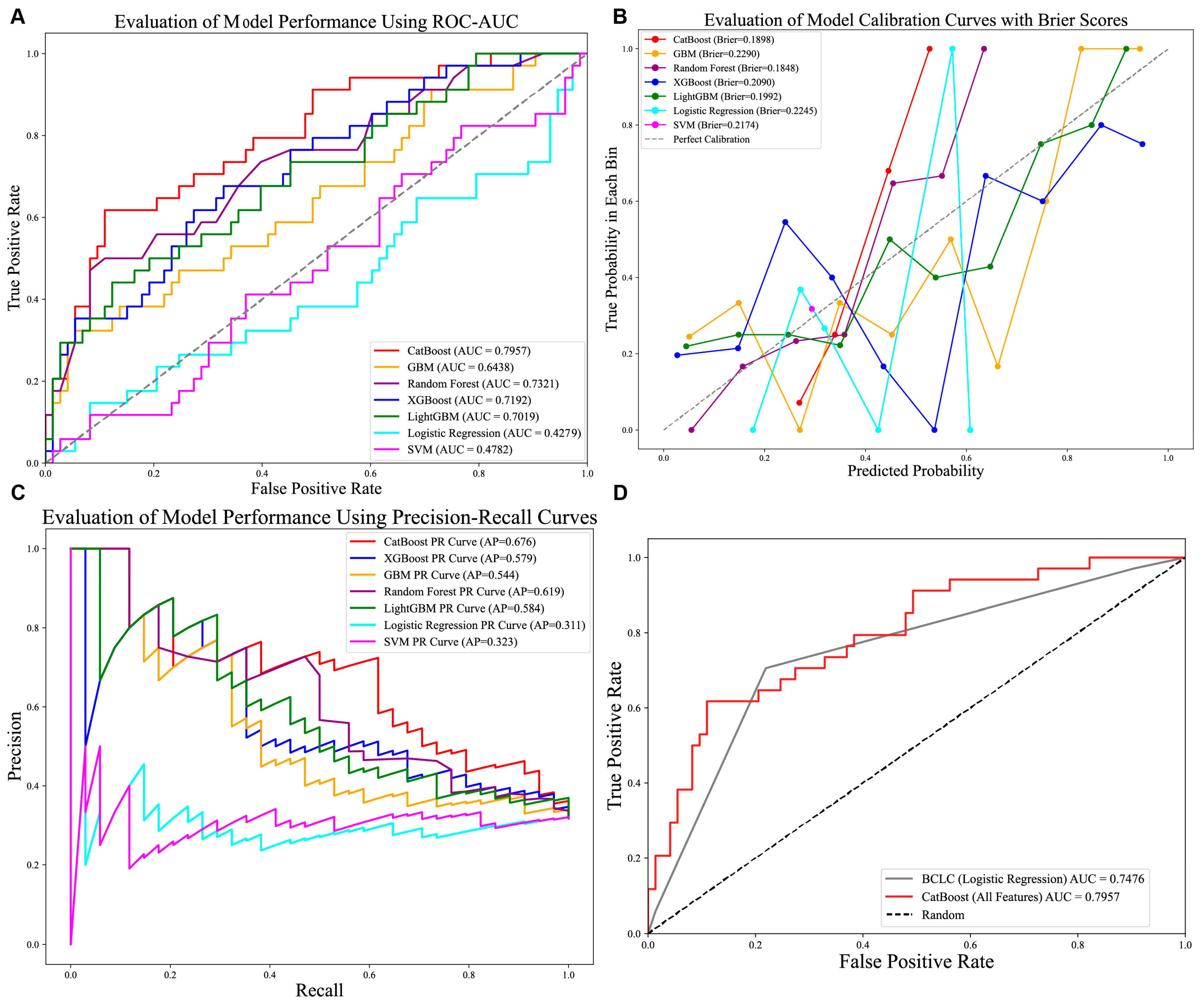
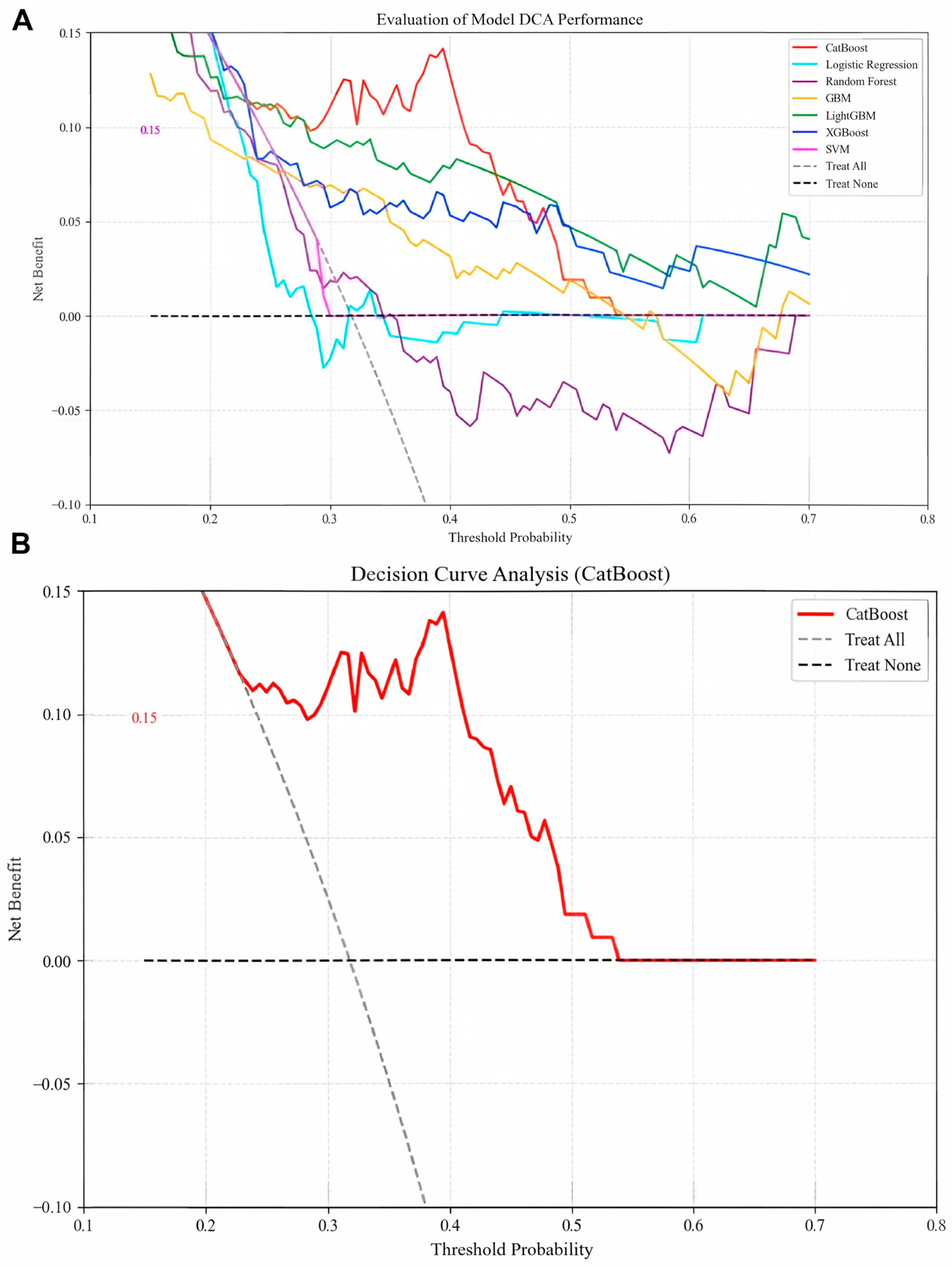

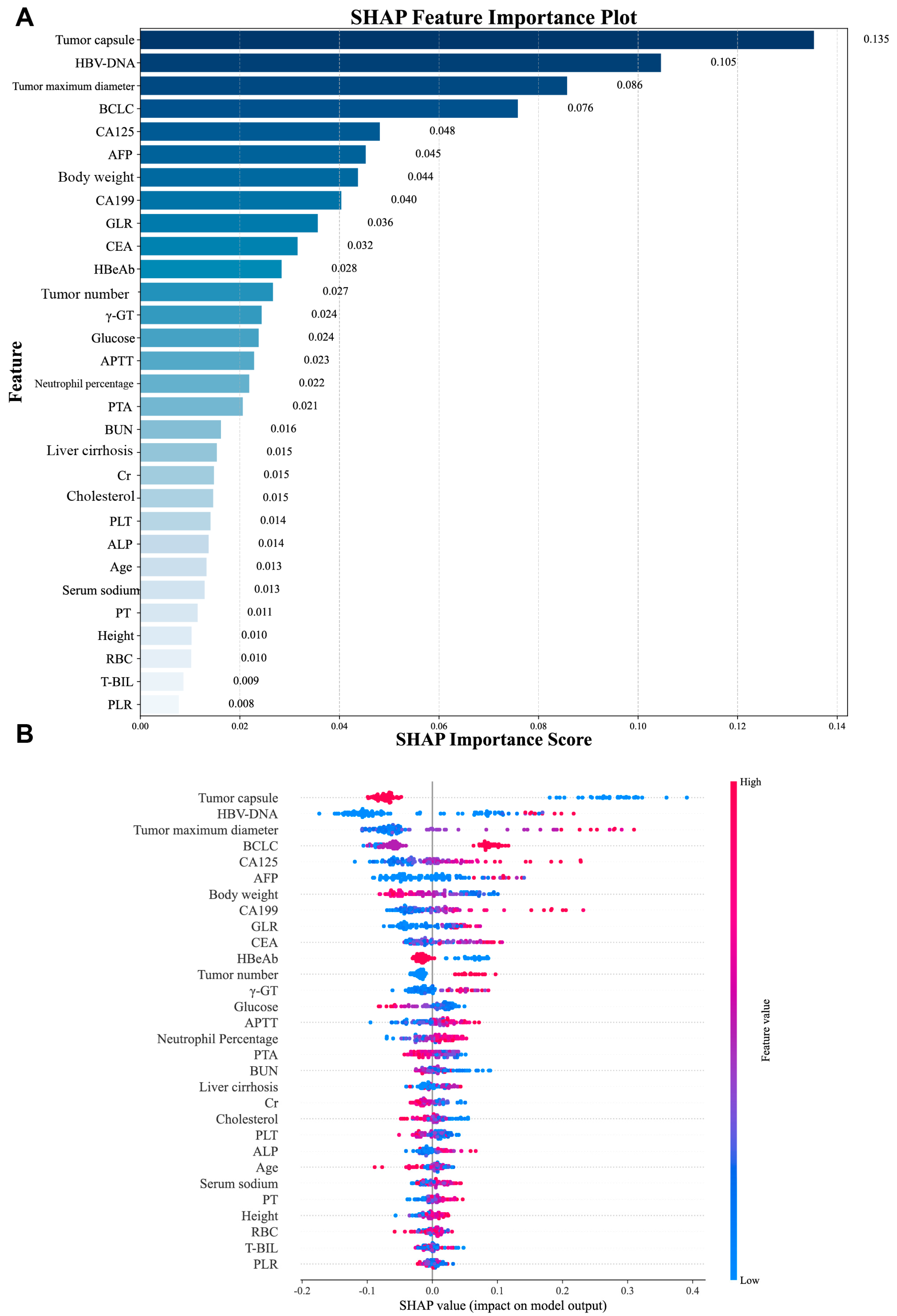
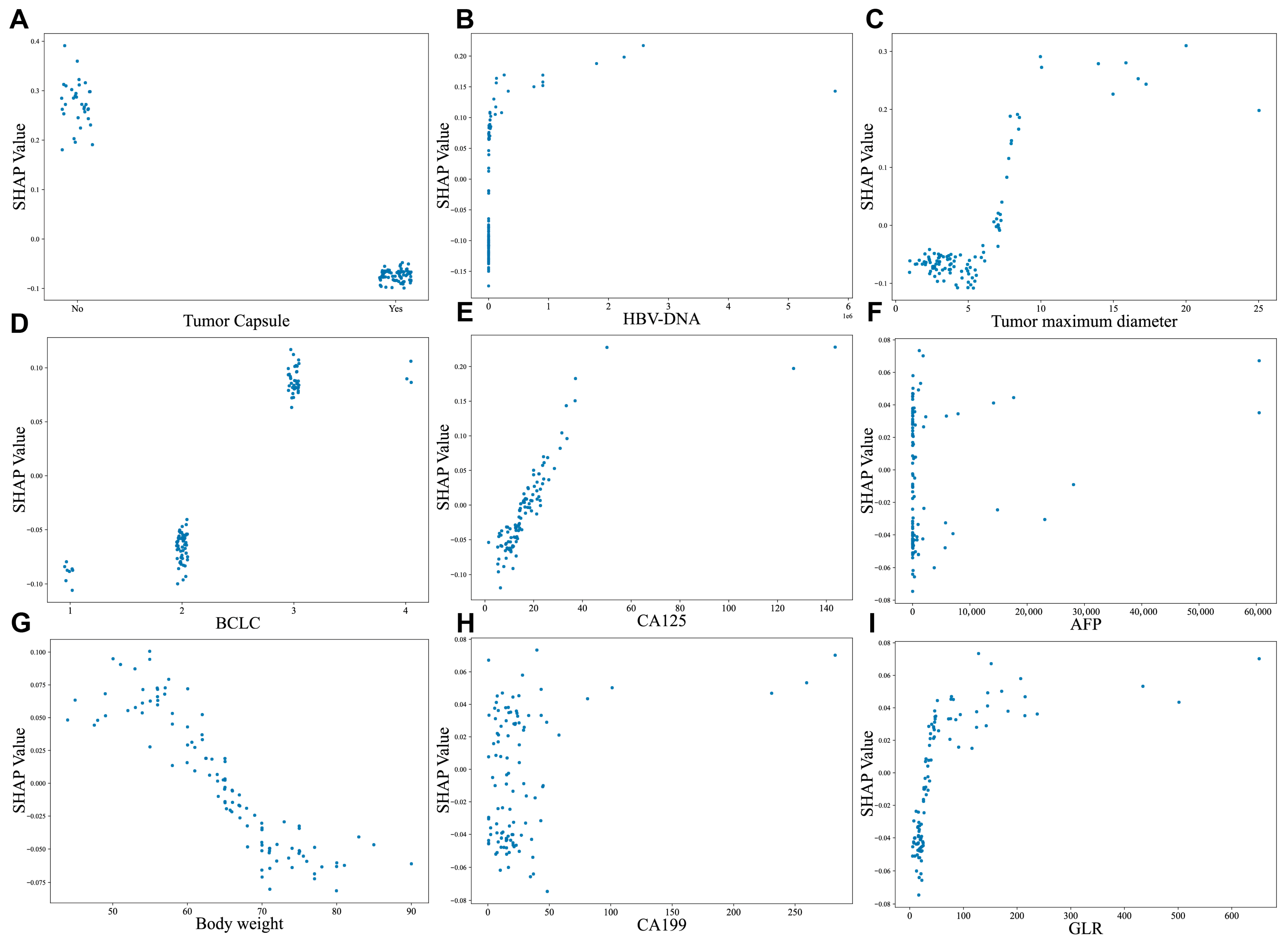
| Feature | Non-Recurrence | Recurrence | p-Value |
|---|---|---|---|
| (n = 248) | (n = 107) | ||
| Age, mean (SD) | 55.0 (15.0) | 53.0 (14.0) | 0.0341 |
| Tumor maximum diameter | 4.40 (3.10) | 6.10 (5.20) | 0 |
| CA125 | 14.15 (9.77) | 16.90 (12.37) | 0.0001 |
| GLR | 26.84 (30.37) | 45.30 (59.36) | 0.0001 |
| AFP | 14.04 (342.78) | 114.20 (1657.60) | 0.0001 |
| AST | 26.00 (12.00) | 31.00 (19.50) | 0.0001 |
| γ-GT | 41.00 (43.25) | 56.00 (84.00) | 0.0005 |
| HBV-DNA | 177.00 (24,050.00) | 3120.00 (167,400.00) | 0.0027 |
| ALB | 41.95 (5.67) | 40.60 (5.60) | 0.0037 |
| Cr | 76.00 (16.25) | 70.00 (19.50) | 0.008 |
| PIVKA-II | 173.00 (1212.75) | 381.00 (2752.50) | 0.0124 |
| eGFR | 94.60 (15.53) | 96.00 (15.10) | 0.0214 |
| ALP | 76.00 (30.25) | 81.00 (46.00) | 0.0658 |
| D-BIL | 4.70 (2.83) | 5.30 (3.05) | 0.0705 |
| Neutrophil Percentage | 58.40 (13.07) | 60.70 (11.90) | 0.1124 |
| Blood glucose | 5.19 (1.04) | 5.08 (0.94) | 0.115 |
| INR | 1.06 (0.11) | 1.07 (0.10) | 0.138 |
| BUN | 5.40 (1.71) | 5.10 (1.91) | 0.1496 |
| CA199 | 15.36 (16.42) | 16.73 (19.27) | 0.1722 |
| Serum sodium | 140.95 (2.50) | 141.00 (2.40) | 0.1904 |
| Cholesterol | 3.69 (1.10) | 3.58 (1.12) | 0.2329 |
| Neutrophil Count | 2.88 (1.66) | 3.12 (1.36) | 0.2434 |
| CEA | 2.73 (1.15) | 2.67 (1.42) | 0.4103 |
| Body weight | 65.90 ± 8.84 | 63.60 ± 9.05 | 0.0258 |
| PTA | 90.76 ± 11.55 | 88.93 ± 10.25 | 0.1596 |
| APTT | 38.28 ± 3.74 | 38.76 ± 3.69 | 0.2675 |
| Gender, n | |||
| Male | 220 | 89 | 0.2106 |
| Female | 28 | 18 | |
| Tumor capsule, n | |||
| Absence | 41 | 44 | 0 |
| Presence | 207 | 63 | |
| BCLC, n | 0 | ||
| 0 | 23 | 2 | |
| A | 146 | 34 | |
| B | 76 | 65 | |
| C | 3 | 6 | |
| HBeAb, n | 0.1299 | ||
| Negative | 56 | 33 | |
| Positive | 192 | 74 | |
| Tumor number, n | 0 | ||
| Single | 210 | 59 | |
| Multiple | 38 | 48 | |
| ASA score, n | 0.9222 | ||
| 1 | 17 | 8 | |
| 2 | 164 | 70 | |
| 3 | 66 | 29 | |
| 4 | 1 | 0 |
| Model | Accuracy | Precision | Recall | F1-Score | AUC Score |
|---|---|---|---|---|---|
| LR | 0.6822 | 0.6267 | 0.6822 | 0.5696 | 0.4279 |
| SVM | 0.6822 | 0.4655 | 0.6822 | 0.5534 | 0.4782 |
| Random Forest | 0.7196 | 0.7336 | 0.5745 | 0.5556 | 0.7321 |
| GBM | 0.7009 | 0.6790 | 0.7009 | 0.6802 | 0.6438 |
| XGBoost | 0.7290 | 0.7208 | 0.7290 | 0.6855 | 0.6869 |
| CatBoost | 0.7290 | 0.7132 | 0.7290 | 0.7123 | 0.7957 |
| LightGBM | 0.7009 | 0.7921 | 0.7009 | 0.5949 | 0.7019 |
Disclaimer/Publisher’s Note: The statements, opinions and data contained in all publications are solely those of the individual author(s) and contributor(s) and not of MDPI and/or the editor(s). MDPI and/or the editor(s) disclaim responsibility for any injury to people or property resulting from any ideas, methods, instructions or products referred to in the content. |
© 2025 by the authors. Licensee MDPI, Basel, Switzerland. This article is an open access article distributed under the terms and conditions of the Creative Commons Attribution (CC BY) license (https://creativecommons.org/licenses/by/4.0/).
Share and Cite
Wang, C.; Ding, Q.; Liu, M.; Liu, R.; Zhang, Q.; Zhang, B.; Song, J. Machine Learning-Based Models for the Prediction of Postoperative Recurrence Risk in MVI-Negative HCC. Biomedicines 2025, 13, 2507. https://doi.org/10.3390/biomedicines13102507
Wang C, Ding Q, Liu M, Liu R, Zhang Q, Zhang B, Song J. Machine Learning-Based Models for the Prediction of Postoperative Recurrence Risk in MVI-Negative HCC. Biomedicines. 2025; 13(10):2507. https://doi.org/10.3390/biomedicines13102507
Chicago/Turabian StyleWang, Chendong, Qunzhe Ding, Mingjie Liu, Rundong Liu, Qiang Zhang, Bixiang Zhang, and Jia Song. 2025. "Machine Learning-Based Models for the Prediction of Postoperative Recurrence Risk in MVI-Negative HCC" Biomedicines 13, no. 10: 2507. https://doi.org/10.3390/biomedicines13102507
APA StyleWang, C., Ding, Q., Liu, M., Liu, R., Zhang, Q., Zhang, B., & Song, J. (2025). Machine Learning-Based Models for the Prediction of Postoperative Recurrence Risk in MVI-Negative HCC. Biomedicines, 13(10), 2507. https://doi.org/10.3390/biomedicines13102507






